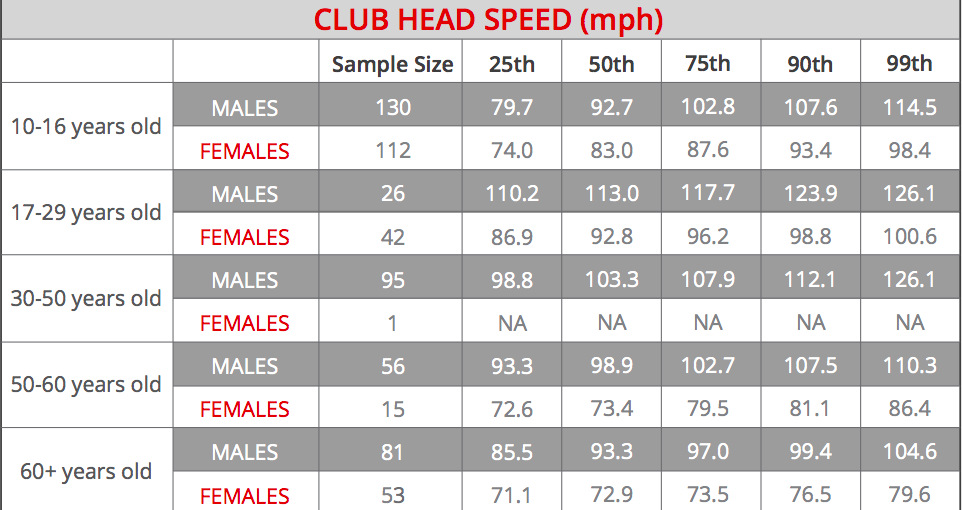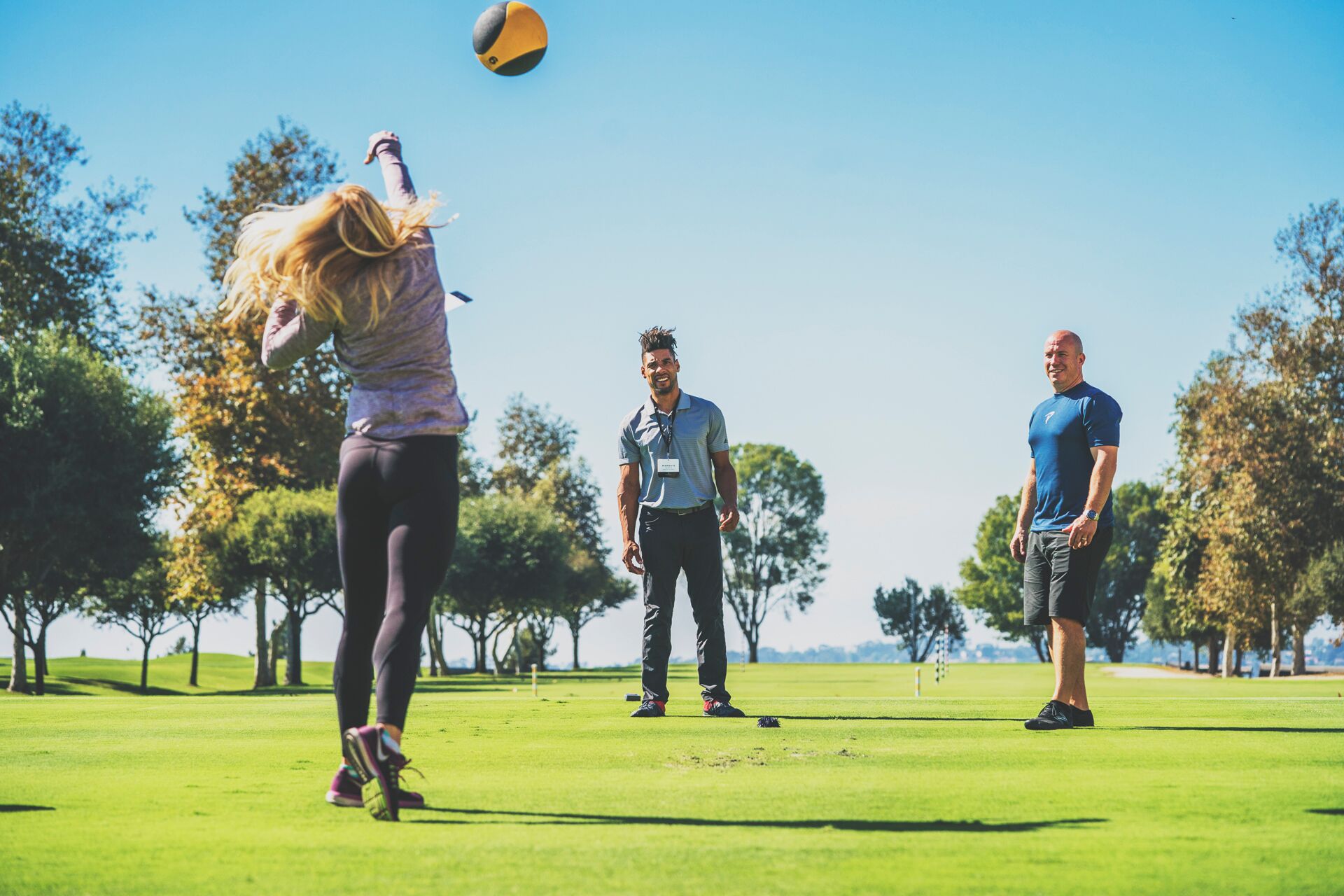IMPROVE MY GAME
Articles
Club Head Speed By Age Group: What Percentile Are You In?

Over the past four years at Par4Success, we have been working with and testing juniors, amateurs, professionals and senior golfers in the state of North Carolina and throughout the country. Our mission has been to collect information and data on all of these “average” golfers to better understand how to help the 99 percent of us that love and play the game of golf.
From all of this testing, over 600 data points at this time, we have been able to identify a number of top metrics in the physical realm that you should be striving for if you want to play at your highest level. While we have identified over 10 critically important metrics for golfers, today we wanted to share the one that is most asked about...club head speed.
If you are in the golf industry, you have no doubt worked with a golfer who swings, looks at his/her speed and then turns to you to ask, “is that good?” If you are like us before we had this data, you likely pull from your memory bank of other golfers you have worked with to compare the person in front of you to them...not the most scientific or accurate approach.
This is one of the most important questions to answer as most of the data out there is on PGA and LPGA tour averages. To have 13 and 65 year olds comparing themselves to the 113 mph PGA Tour average or the 98 mph LPGA Tour average is silly (and, in some cases, potentially dangerous). It is like the average person comparing their wealth to Warren Buffet...let’s be serious and come up with a realistic and helpful comparison of where you are today and where you want to be in a few months and even decades from now.
On the LPGA and PGA Tours, it is very clear that length matters with most of the top money earnings belonging to the longer hitters. It is a reasonable assumption to make that the same would be true with amateurs, juniors and seniors around the world. The longer you hit it, the easier it should be for you to score better. You will have a shorter approach and hopefully avoid hitting a hybrid into every green.
Before we go any further, however, please do not mistake the previous statement to mean that you "have" to be a super long hitter to play on a professional Tour or to play at a high level. You can clearly make a living on Tour not swinging 120 mph and play at a very high amateur level not hitting it 300 yards. The stats clearly show, however, that length helps a ton when it comes to earning dollars on Tour.1
When children are little, all parents reading this remember being told by the physician what percentile your child's height and weight were. While this is a fun metric, it doesn't tell you how tall they will be, how good of an athlete they will be or anything else predictive of their future. It does, however, give you an objective metric to be able to understand where your child stands at that moment compared to other children of the same sex and age.
With our data, we have done exactly that for club head speed. The percentiles that follow below are meant to help you in a few ways depending on where you are in your golfing life.
If you are a junior golfer, the hope is that this data allows you to see where you stand compared to others in your age range and the older golfers at the next level. For example, if you are 10-16 years old and want to see how fast the college kids you will be playing against will be swinging, take a look at the 17-30 age group. The hope is that this gives you a target of where you may want to get to in order to be most competitive with the other players you are competing against.
If you are a working amateur in your 30-50’s, hopefully this gives you a realistic expectation of what is actually good for your age and how much your peers are losing on average over the years when it comes to speed. Use this data as a barometer to identify losses in power that would be abnormal for your age.
If you are 50+, the hope with this data is that you gain a realistic understanding of where you are vs where you could be. In fact, a 90 mph club head speed when you are 65 years old is not that good and there is likely lots of room for improvement!
Utilizing this data, industry professionals should be able to tell golfers who have forced themselves to accept that they are just getting old, that in fact, they are wrong. There is ample opportunity to improve and get better well into your 60’s if you have an organized and sport science based plan.

The next logical question for everyone not in the 99th percentile, of course, is probably "how do I get more club head speed?" That answer lies in science and one of the four quadrants of speed. The four quadrants that a player can gain speed in are improving technical efficiency, improving equipment to match the player’s needs of speed with consideration for accuracy, improving mobility to allow full rotational capacity and improving power. Power is the simple sum of how much force a player can generate plus how fast they can produce that force. Simply put, Power = Strength + Speed.

Depending on where a player is in their golf lifecycle, the solutions to speed may vary in order of importance. For example, if we have two players, a senior with poor mobility and a junior with hypermobility and compare them, their increased club head speed solutions will be very different. For this example, let’s assume that equipment and technical efficiency are equal in both players. The senior player will see greater improvement in club head speed with mobility improvements. The junior player will likely see greater improvements in their club speed with a focus on improving strength and control of their mobility.
This isn’t to say that both players should ignore the other areas of the four quadrants, but rather, that the greater majority of their time should be spent addressing the low hanging fruit first. For example, the hypermobile junior will still work on mobility, but instead of trying to increase it, they would work on better control of their end ranges and throughout their entire range of motion. This might happen during active rest breaks between strength and power training. This will have the added benefit of injury prevention as well.
The senior player will not ignore strength and speed training, but likely use eccentric strength training periods throughout the year. This will help further their mobility gains while also working on strength. See my earlier mytpi article on the benefits of eccentric training here. The senior player will also work on speed and deceleration drills (sport specific, vertical, horizontal and torsional) to increase their speed. This will all be done, however, after a significant focus on soft tissue work, mobility drills and attention to golf specific rotary centers.
Knowing what percentile you are in for your age/sex can be the starting benchmark for you and help you set goals to shoot for. It is important you utilize a sports science based plan designed to maximize your return on the your time spent as demonstrated above. Seek out the guidance of a golf fitness/medical and teaching professional who can help you assess where you are and identify the quadrants of speed that you need to focus on most.

A note about the data. It is important to note that the age groups with the larger sample sizes can be extrapolated out much more than those with smaller ones. This is just the beginning of the database we are collecting and numbers will only grow and become more helpful. If you are a 30-50 year old female, please reach out so we can fill your age group’s numbers in as there is clearly a gap in our data for your age group.
Be on the lookout for the upcoming article on the top tests that we found related to identifying your low hanging fruit when it comes to producing club head speed based on your age. These tests have a very high correlation to club head speed and can shed light for you as to which quadrant you should be focusing on to improve your club head speed. If you’d like to see our full full free research report with all of the numbers from age 10-65+ You can download the full free report here.
At Par4Success, our speciality is helping golfers play better golf, swing faster and hurt less. The average golfer based on our research and in our programs, will see over 3 mph gain (~10 yards) in less than 12 weeks and many see much more; 50% more when they use the specific type of power and strength training most dialed in for their age and developmental level. Let us know if we can help you reach your goals!

Chris Finn is a Licensed Physical Therapist, Certified Strength and Conditioning Specialist, Titleist Performance Institute Certified Medical Professional, Certified Precision Nutrition Coach, and trained to perform Trigger Point Dry Needling in North Carolina. Since starting Par4Success in 2012, Chris has and continues to work with Touring Professionals, elite level juniors & amateurs as well as weekend warriors. He has contributed to numerous media outlets including GolfWRX, is a published author, works with many of the nation’s leading coaches and instructors to improve their players and presents all over the country on topics such as Golf Performance, Junior Golf Athletic Development, Injury Prevention and Power/Speed improvement for golfers.
References:
- https://golfweek.com/2018/04/22/golf-by-the-numbers-distance-off-tee-pays-dividends/